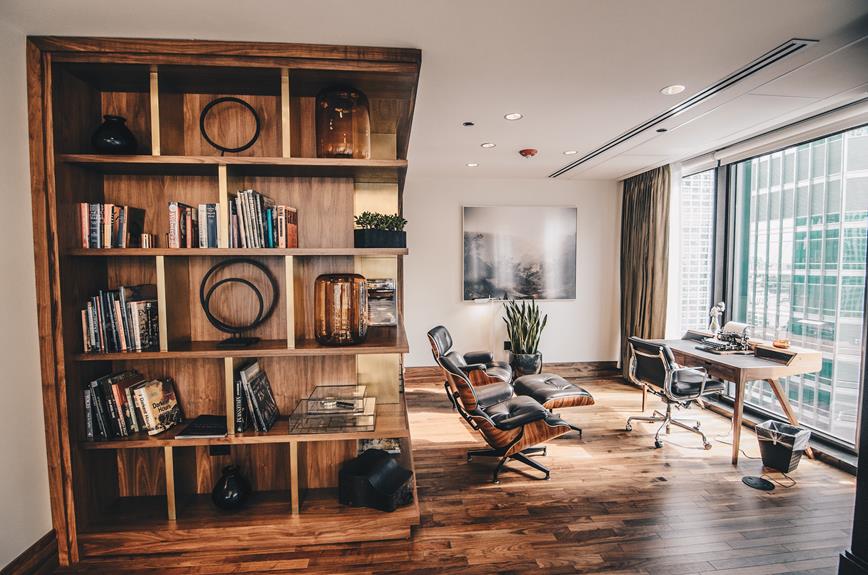You've probably heard the saying, 'A place for everything, and everything in its place.'
When it comes to setting up your home office, finding the right filing cabinet is essential. But with so many options out there, how do you choose the right one for your specific needs and space?
Let's walk through some key considerations to help you make an informed decision that will keep your important documents organized and easily accessible.
Key Takeaways
- Assess available space and cabinet dimensions to ensure the filing cabinet fits in your home office.
- Consider the material and durability of the filing cabinet, choosing one that meets both functional and aesthetic needs.
- Install a robust locking mechanism for document security, considering options like key locks or combination locks.
- Implement a clear and consistent labeling system and utilize additional organizational tools like dividers or folders for easy file retrieval.
Size and Space Considerations
When choosing a home office filing cabinet, consider the available space in your office and the dimensions of the cabinet to ensure a proper fit. Storage solutions and space optimization are crucial when setting up a functional home office. It's essential to assess the amount of space you have for the filing cabinet and how it will fit into the overall layout of your office. A compact design and efficient layout can make a significant difference, especially if you have limited space to work with.
Before purchasing a filing cabinet, measure the area where you intend to place it. Take into account any other furniture or equipment in the room to ensure that the cabinet won't overcrowd the space. Consider vertical space as well – if floor space is limited, a taller filing cabinet might be a better storage solution. Additionally, think about the accessibility of the cabinet within the room. You'll want to ensure that the drawers can be fully extended without obstruction.
When considering the dimensions of the filing cabinet, think about your current and future storage needs. If you anticipate a growing volume of paperwork, it's wise to invest in a cabinet with ample storage capacity without taking up excessive floor space. By carefully evaluating the available space and the cabinet's dimensions, you can optimize your office layout for maximum efficiency.
Material and Durability
When choosing a filing cabinet for your home office, it's important to consider the material and durability.
Different materials offer varying levels of strength and aesthetic appeal, so think about what'll work best for your space.
Durability factors such as weight capacity and long-term use should also be taken into account when making your decision.
Material Options
Consider the material options for your home office filing cabinet, focusing on durability and aesthetic appeal. When choosing the material for your filing cabinet, consider factors such as color options, design flexibility, maintenance requirements, and environmental impact. Here is a comparison of common filing cabinet materials:
| Material | Durability | Aesthetic Appeal |
|---|---|---|
| Steel | High | Limited |
| Wood | Moderate | High |
| Plastic | Low | Limited |
Steel filing cabinets offer high durability but may have limited aesthetic appeal. Wood cabinets provide moderate durability and high aesthetic appeal. Plastic cabinets have low durability and limited aesthetic appeal. Consider these material options carefully to ensure your filing cabinet meets both your functional and aesthetic needs.
Durability Factors
To assess the durability of your home office filing cabinet, evaluate the material and its impact on longevity.
Durability testing is crucial to ensure that the cabinet can withstand the demands of daily use. Metal filing cabinets are known for their durability, but they can be prone to dents and scratches.
On the other hand, wood filing cabinets are sturdy and can withstand heavy loads, but they may be susceptible to warping and water damage.
It's important to consider the warranty coverage offered by the manufacturer, as this can provide insight into the expected lifespan of the filing cabinet. Look for cabinets with a solid warranty that covers structural integrity and functional components.
Long-Term Use
Assess the material and warranty coverage to ensure your home office filing cabinet will withstand long-term use. Look for cabinets made of steel, which offers durability and strength, or wood for a classic look. Steel cabinets are resistant to dents and scratches, while wood cabinets should be made of high-quality, solid wood to ensure longevity.
Consider the warranty coverage to protect against defects and damage that may occur over time. Additionally, think about long-term maintenance when choosing a filing cabinet. Consider how easily the cabinet can be cleaned and maintained over the years.
Moreover, anticipate your future needs. Choose a filing cabinet with enough storage space to accommodate your growing collection of documents and files. By considering these factors, you can select a filing cabinet that will meet your long-term home office needs.
Security Features
You want to make sure your home office filing cabinet has a reliable locking mechanism to keep your documents secure.
Additionally, consider investing in a fireproof option to protect important papers in case of an emergency.
These security features are essential for safeguarding your sensitive information and ensuring peace of mind.
Locking Mechanism
Consider installing a robust locking mechanism to ensure the security of your important documents and files within the filing cabinet. When choosing a locking mechanism for your home office filing cabinet, it's essential to consider the level of security you need and the convenience of access. Here are two common types of locking mechanisms to consider:
| Locking Mechanism | Description | Pros | Cons |
|---|---|---|---|
| Key Lock | Requires a physical key to unlock the cabinet. | Provides reliable security and is straightforward to use. | Risk of losing the key, potential for unauthorized duplicates. |
| Combination Lock | Unlocks with a designated code or combination. | No need for keys, multiple authorized users can access. | Forgetting the combination, possibility of unauthorized access if the code is not well-protected. |
Choose a locking mechanism that aligns with your security needs and provides ease of use for authorized users.
Fireproof Options
When it comes to safeguarding your important documents, considering fireproof options for your home office filing cabinet is crucial for added security and protection. Look for cabinets with fireproof certification to ensure that your documents are safe in the event of a fire.
Fireproof filing cabinets are designed with advanced insulation technology to withstand high temperatures and prevent the contents from burning. The fireproof certification indicates that the cabinet has been tested and meets specific standards for fire resistance. This extra layer of protection can provide peace of mind knowing that your sensitive documents, such as contracts, deeds, or financial records, are secure even in the face of a fire emergency.
When shopping for a filing cabinet, prioritize fireproof options to safeguard your most important paperwork.
Organizational Capabilities
Maximizing your filing cabinet's organizational capabilities is essential for maintaining an efficient and clutter-free home office. To achieve this, consider the following crucial factors:
- Labeling System and File Categorization: Implementing a clear and consistent labeling system for your files is paramount to staying organized. Whether you opt for color-coded labels, alphabetical order, or numerical filing, the key is to choose a method that works best for your specific needs. Categorizing your files into sections such as financial documents, client information, or project materials will further streamline your filing system, making it easier to locate important paperwork when needed.
- Accessibility and Ease of Retrieval: When selecting a filing cabinet, prioritize accessibility and ease of retrieval. Choose a cabinet with smooth-gliding drawers and sturdy handles to ensure effortless access to your files. Additionally, consider the depth of the drawers to accommodate various file sizes without cramming or overcrowding, which can lead to disorganization.
- Space Optimization: Opt for a filing cabinet that maximizes space utilization. Look for features such as adjustable shelving or additional compartments to store office supplies, stationery, or other items alongside your files, thereby optimizing the use of your office space.
Style and Aesthetics
To ensure a cohesive and visually appealing home office, carefully consider the style and aesthetics of your filing cabinet. Aesthetics play a significant role in creating an inspiring and productive work environment. When choosing a filing cabinet, you want to ensure that it not only serves its functional purpose but also adds to the overall aesthetic appeal of your home office.
Fortunately, there are various design options available to suit different styles and preferences. If your home office has a modern and minimalist design, you might opt for a sleek, metal filing cabinet with clean lines and a neutral color palette. This can complement the contemporary feel of the space while providing the necessary storage for your documents.
On the other hand, if your home office has a more traditional or rustic ambiance, a wooden filing cabinet with ornate details and warm, rich tones might be a better fit. This can add a touch of classic elegance to the room while keeping your files organized and easily accessible.
Consider the overall color scheme and furniture in your home office when selecting a filing cabinet. You'll want it to harmonize with the existing decor and contribute to the cohesive look of the space.
Mobility and Accessibility
Consider the ease of movement and accessibility when choosing a filing cabinet for your home office. The ability to easily move and access your filing cabinet is crucial for a functional home office setup. Here are some key considerations to keep in mind:
- Portability: Look for filing cabinets with built-in casters or wheels that allow for easy mobility. This feature enables you to move the cabinet around your office space as needed, making it effortless to rearrange your work area or access files from different locations. Additionally, consider the size and weight of the filing cabinet to ensure that it can be easily transported if necessary.
- Accessibility: Prioritize filing cabinets with drawers that fully extend and provide easy access to your documents. This ensures that you can reach all your files without struggling or having to remove other items from the drawers. Cabinets with smooth-gliding drawer mechanisms contribute to seamless accessibility, allowing you to retrieve and organize your documents efficiently.
- Storage Capacity: While considering portability and accessibility, also evaluate the storage capacity of the filing cabinet. Ensure that it offers sufficient space to accommodate your current and future filing needs without compromising mobility and accessibility. Balancing storage capacity with ease of movement and accessibility is essential for a well-functioning home office filing system.
Budget and Value
When prioritizing your budget for a home office filing cabinet, ensure that you're getting the best value for your money. Budget constraints are a real consideration, but that doesn't mean you have to sacrifice quality. Look for cost-effective options that offer durability and functionality. Consider the long-term value of the filing cabinet rather than just the initial cost.
One way to maximize your budget is to consider the materials used in the construction of the filing cabinet. While solid wood cabinets may be aesthetically pleasing, they can be costly. However, there are high-quality alternatives such as laminate or metal cabinets that offer durability at a more affordable price point.
Another cost-effective option is to consider the size of the filing cabinet. Larger cabinets will naturally cost more, so think about your storage needs carefully. If you have a smaller home office and don't need to store a large volume of documents, a compact filing cabinet may be a more budget-friendly choice.
Moreover, consider the features that are essential for your work. Some filing cabinets come with extra security features or organizational add-ons that can increase the cost. If these features aren't crucial for your needs, opting for a simpler model can help you stay within your budget.
Frequently Asked Questions
Can the Filing Cabinet Accommodate Legal-Sized Documents as Well as Standard Letter-Sized Documents?
Yes, the filing cabinet accommodates both legal-sized and standard letter-sized documents, offering versatility for document organization. This ensures space efficiency and optimal document storage, making it an ideal choice for your home office.
Are There Any Environmental Considerations for the Materials Used in the Filing Cabinet's Construction?
You may wonder about the environmental impact of the filing cabinet materials. Many options use recycled materials, promoting sustainability. Also, consider eco-friendly choices to avoid material toxicity and support a greener home office.
Does the Filing Cabinet Have Fireproof or Water-Resistant Features for Added Protection of Important Documents?
Yes, the filing cabinet is fireproof and has water-resistant features for added protection. It ensures safety for your important documents, providing peace of mind. These features are valuable for safeguarding your files in case of emergencies.
How Easy Is It to Label and Categorize Files Within the Filing Cabinet?
Labeling efficiency in your filing cabinet is key for easy file organization. With clear tabs, color-coded labels, and spacious drawers, categorizing documents becomes a breeze. It streamlines your workflow and keeps your office tidy.
Are There Any Additional Accessories or Add-Ons Available for the Filing Cabinet, Such as Extra Shelves or Dividers?
Yes, there are extra storage and organization options available for the filing cabinet. You can find additional shelves, dividers, and other accessories to customize the cabinet according to your specific needs and preferences.





